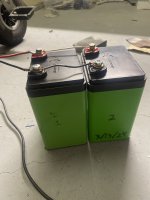The point of a BMS shutting off the ability to charge (if that is what has happened, vs a BMS failure) is that the cells are beyond what is safe to recharge.
If you want to go ahead and do it, you should test everything first to find out *why* it shut off charge. If the cells are below the BMS LVC, then you are risking a fire, not just then, but at every moment of every hour of every day that the pack exists after that.
That's why the BMS is designed to do this, to prevent fires.
It doesn't matter if the cells had *zero* cycles; if they're damaged they're damaged. (which you can't know for certain--the only way to know if a cell is *going* to catch fire is *when* it catches fire...so the "safe" way to go about it is assuming any cell that's has had an excursion outside it's normal voltage range, or temperature, etc., is damaged). While LiFePO4 is probably safer than some other chemistries, it can still catch fire.

If the problem is not the cells, but a blown fuse, failed connection, damaged BMS, etc., and all of the cells are all above the BMS LVC and below it's HVC, then they're *probably* safe to recharge.
Up to you what to do.
Some people have successfully recovered even 0V cells...but the cells have still gone outside their design range and may be damaged, possibly in a way that can cause a fire. You just can't know.

You can check with K2 Energy to see what it is for those specific cells in those packs, but the usual LVC for LiFePO4 cells (probably what's in this pack from it's labelling) is about 2.4-2.5v. Below that there's little or no energy. Below about 2.1v, the likelihood of damage is higher the lower you go.
The usual HVC for those is about 3.65v, most of the time as they age they only retain about 3.4v after charging up to 3.65v. Above 3.65v, the likelihood of damage gets higher the higher you go.


